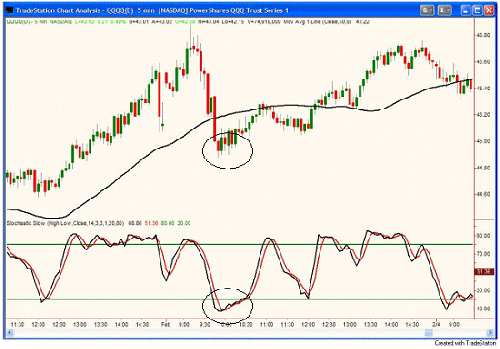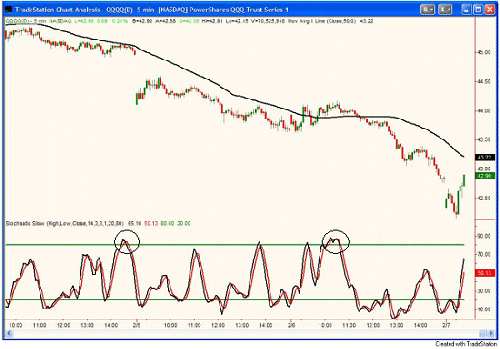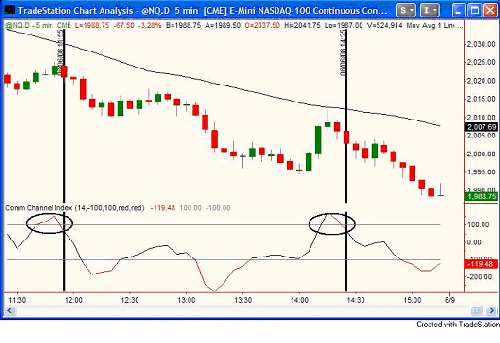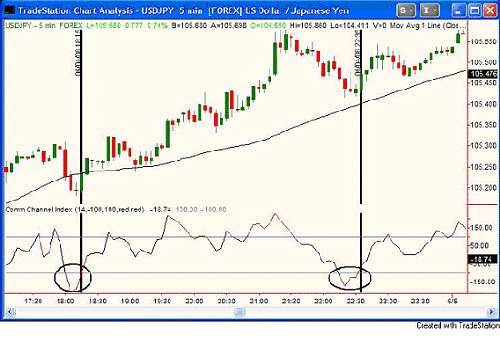Advances in technology have been the driving force behind the change and growth in the world of market speculation. One of the many recipients of faster and stronger technology is system trading as high speed computers now help retail and institutional traders develop systems, crunch numbers, and back test hypothetical results in seconds. In the world of professional money management, I have seen plenty of trading systems. Ironically, most don't seem to work and of the ones that do, they typically work for a bit and then fail. Being on the education side of the industry as well, I have seen hundreds of automated systems yet, I can only say that I have seen less than a hand full actually produce a consistent profit year after year. I often get emails from people who have read an article I wrote that want to share an automated strategy with me. They are sending it so I will help them review it and perhaps improve it. Traders will send me back tested hypothetical performance reports from these strategies that suggest they have the holy grail of trading systems. Most of these will show 80% winning trades or better and huge profits. Most of the time however, when they take the next step and trade the system with real money, they lose and lose fast. With explosive advances in technology and market information, why is system trading so difficult for most who give it a try? There is a very simple reason I will discuss later. In this piece, I will focus on the foundation of a profitable trading system, offer specific tools and rules of a profitable system, and expose the dangerous traps that lead to system trading failure.
The Most Important Aspect of a System
As much change and growth has occurred due to technology, there is one component to trading that has not changed one bit and that is how the consistently profitable trader derives consistent low risk / high reward profits. The key to a proper trading strategy all comes down to the foundation of that strategy. To have the proper foundation, you must have a solid understanding of how markets work and why price moves as it does. If you have one flaw in your thought process, you can be sure it will lead to poor trading results. The reality is that markets are nothing more than pure supply and demand at work, human beings reacting to the ongoing supply/demand relationship within a given market. This alone, ultimately determines price. Opportunity emerges when this simple and straightforward relationship is "out of balance." When we treat the markets for what they really are, and look at them from the perspective of an ongoing supply/demand relationship, identifying sound trading opportunities is not that difficult a task. Market speculators who understand this simple concept and what this opportunity looks like on a price chart typically derive their income from market speculators who don't. In other words, those who "know" get paid from those who "don't know".
Who Is On The Other Side Of Your Trade?
If we want a consistently profitable trading system, we had better make sure that the person on the other side of our trades is a consistent losing trader. Our system had better be an expert at finding a novice trader or we are in trouble. We don't need to know the exact person on the other side of our trade, we just need to know if they are a consistently profitable trader or a consistent losing trader, and the chart will give us most of this information.
Let's face it, when it comes to charting and technical analysis, most active traders use indicators. While many people including myself have often beat up the indicators, they are actually a great tool when used properly for automated or semi-automated trading systems. The problem is that people tend to take every buy and sell signal an indicators produces and this is the last thing you want to be doing. Those who take each buy and sell signal an indicator offers are likely to lose their trading capital fast. It is not that the indicators are doing anything wrong. They will always do what they are programmed to do. The key for the trader is to use them in conjunction with proper trend analysis. One of the great benefits to using indicators and oscillators the right way is that they allow you to trade based on a mechanical set of rules. Let's use a single moving average and stochastics in our attempt to use indicators in our system to find the consistent losing trader to trade with.

Above is a chart of the QQQQ. On the chart is a 50 period moving average and a slow stochastic oscillator. To begin with, we must assess the trend of prices in this market. For this task, I use a 50 period moving average. Notice that the slope of the moving average is up suggesting we are in an uptrend. Once we know this, we only want to buy pullbacks in price. The mechanical signal to buy comes when the stochastic produces a buy signal in over sold territory (moving average cross, circled above). While this turned into a nice low risk buying opportunity, notice the price action just prior to this buying opportunity in the QQQQ. During the uptrend, the stochastic was very overbought, producing sell signals during much of the uptrend which would have led to many losses had you sold short at those times. This is a trap new traders can fall into when using these tools without reality based logical rules.
Buy Rule: When the moving average is sloping upwards, take the stochastic moving average cross in oversold territory as a buy signal. When the moving average is sloping upwards, IGNORE EVERY sell signal the stochastic moving average cross in overbought territory produces.
The Reality Based Logic: When prices are moving higher, we want to find a buying opportunity when things are on sale. Most importantly, our buy signal told us objectively that someone was selling after a decline in price and selling in the context of an uptrend. This can only be the action of a novice seller. A consistently profitable trader would never sell after a decline in price and in the context of an uptrend.

On this chart, we also have a 50 period moving average and a slow stochastic oscillator. Here, the slope of the 50 period moving average tells us the trend is down. Once we know this, we only want to sell to a novice trader who is buying after a move higher in price in the context of a down trend. The mechanical signal to sell comes when the stochastic produces a sell signal in over bought territory (moving average crosses, circled above).
Sell Short Rule: When the moving average is sloping downwards, take the stochastic moving average cross in overbought territory as a sell signal. When the moving average is sloping downwards, IGNORE EVERY buy signal the stochastic moving average cross in oversold territory produces.
The Reality Based Logic: When prices are trending down, we want to find a shorting opportunity when prices are high. Furthermore, we want to sell short to the buyer who is buying after a rally in price and in the context of a downtrend (a novice buyer).
Is this or any trading system perfect? Certainly not, there is no perfect trading system and there doesn't need to be. If there was, that person would have all the worlds' money. However, wrapping some simple rules and logic around your trading is the key to stacking the odds in your favor. Even Las Vegas does not win all the time. They do well over time because they realize they don't have to always win. They just need to stick to their rules that allow them to keep the edge which means betting against people who don't have the edge.
Any Market and Indicator Will Do When You Think the Markets Correctly

This is an intra-day chart of the NASDAQ Futures with the same 50 period moving average. In this example, I simply switched the Stochastic for the Commodity Channel index, better known as CCI, we will get almost the same signals.
Technical Reason for Shorting:
1) The down sloping 50 - period moving average suggests this market is in a downtrend.
2) A CCI Overbought reading (circled are on the chart).
Logical Reason for Shorting: Sell short to a buyer who buys AFTER a rally in price and in the context of a downtrend. The only type of mindset that would take this action is someone who makes decisions to buy and sell anything based on EMOTION, not simple and proper logic. This is the pedigree of the trader we want on the other side of our trades.
Trading strategies that work don't change with time, markets, or changing market conditions. Quite frankly, to think market conditions ever change at all is a strong illusion that can only be removed when one focuses on the foundation of price movement, pure supply and demand. The systems I see working are very simple. The example below is an intra-day chart of the Dollar/Yen. Let's apply our same basic principles.

Technical Reason for Buying:
1) The up sloping 50 - period moving average suggests this market is in an uptrend.
2) A CCI Oversold reading (circled are on the chart).
Logical Reason for Buying: Buy from a novice seller who sells AFTER a decline in price and in the context of an uptrend.
Summary
Turning Failure Into Success
I see the vast majority of traders that go down the system path spend years form-fitting indicators and oscillators based on back tested hypothetical results (numbers). I see very few people develop strategies based on the simple logic of how and why price moves as it does in any market. From my reality based market experience, trading is a simple transfer of accounts from those who don't understand simple market logic into the accounts of those who do. Trading systems just expedite the process.
As I mentioned earlier, most traders who develop trading systems don't take this approach or think in the simple terms I am suggesting. Why? It is because of how most people learn about markets and trading. Most will not begin their learning path as I did by handling institutional order flow on the floor of an exchange. The vast majority of market players will start with a trading book or seminar written or delivered by someone who writes books and delivers seminars, NOT a real market speculator. These books are filled with conventional use of indicators and chart patterns that simply don't work. If they did, the author would certainly not be selling the book to you. This leads to a novice trader thinking they can take a trading system short cut and add a few indicators and oscillators to a price chart and let the computer find the parameters for each of those indicators that would have produced the best results in the past (back testing). Typically, when the novice system trader begins trading with real money based on those quality hypothetical results and begins losing money, they take the next wrong step - they begin adjusting indicator settings and worse yet, they add more indicators. This is a path that leads to trading disaster yet the novice system trader does not even know it. They say, "How can a system with such great back tested numbers not work"? It doesn't work because the system is based on number crunching and curve fitted back testing results. The reality of how markets work is ignored. When designing your trading system, make sure you bring your foundation back to the basics of how and why price moves in any and all markets.
The Most Important Aspect of a System
As much change and growth has occurred due to technology, there is one component to trading that has not changed one bit and that is how the consistently profitable trader derives consistent low risk / high reward profits. The key to a proper trading strategy all comes down to the foundation of that strategy. To have the proper foundation, you must have a solid understanding of how markets work and why price moves as it does. If you have one flaw in your thought process, you can be sure it will lead to poor trading results. The reality is that markets are nothing more than pure supply and demand at work, human beings reacting to the ongoing supply/demand relationship within a given market. This alone, ultimately determines price. Opportunity emerges when this simple and straightforward relationship is "out of balance." When we treat the markets for what they really are, and look at them from the perspective of an ongoing supply/demand relationship, identifying sound trading opportunities is not that difficult a task. Market speculators who understand this simple concept and what this opportunity looks like on a price chart typically derive their income from market speculators who don't. In other words, those who "know" get paid from those who "don't know".
Who Is On The Other Side Of Your Trade?
If we want a consistently profitable trading system, we had better make sure that the person on the other side of our trades is a consistent losing trader. Our system had better be an expert at finding a novice trader or we are in trouble. We don't need to know the exact person on the other side of our trade, we just need to know if they are a consistently profitable trader or a consistent losing trader, and the chart will give us most of this information.
Let's face it, when it comes to charting and technical analysis, most active traders use indicators. While many people including myself have often beat up the indicators, they are actually a great tool when used properly for automated or semi-automated trading systems. The problem is that people tend to take every buy and sell signal an indicators produces and this is the last thing you want to be doing. Those who take each buy and sell signal an indicator offers are likely to lose their trading capital fast. It is not that the indicators are doing anything wrong. They will always do what they are programmed to do. The key for the trader is to use them in conjunction with proper trend analysis. One of the great benefits to using indicators and oscillators the right way is that they allow you to trade based on a mechanical set of rules. Let's use a single moving average and stochastics in our attempt to use indicators in our system to find the consistent losing trader to trade with.

Above is a chart of the QQQQ. On the chart is a 50 period moving average and a slow stochastic oscillator. To begin with, we must assess the trend of prices in this market. For this task, I use a 50 period moving average. Notice that the slope of the moving average is up suggesting we are in an uptrend. Once we know this, we only want to buy pullbacks in price. The mechanical signal to buy comes when the stochastic produces a buy signal in over sold territory (moving average cross, circled above). While this turned into a nice low risk buying opportunity, notice the price action just prior to this buying opportunity in the QQQQ. During the uptrend, the stochastic was very overbought, producing sell signals during much of the uptrend which would have led to many losses had you sold short at those times. This is a trap new traders can fall into when using these tools without reality based logical rules.
Buy Rule: When the moving average is sloping upwards, take the stochastic moving average cross in oversold territory as a buy signal. When the moving average is sloping upwards, IGNORE EVERY sell signal the stochastic moving average cross in overbought territory produces.
The Reality Based Logic: When prices are moving higher, we want to find a buying opportunity when things are on sale. Most importantly, our buy signal told us objectively that someone was selling after a decline in price and selling in the context of an uptrend. This can only be the action of a novice seller. A consistently profitable trader would never sell after a decline in price and in the context of an uptrend.

On this chart, we also have a 50 period moving average and a slow stochastic oscillator. Here, the slope of the 50 period moving average tells us the trend is down. Once we know this, we only want to sell to a novice trader who is buying after a move higher in price in the context of a down trend. The mechanical signal to sell comes when the stochastic produces a sell signal in over bought territory (moving average crosses, circled above).
Sell Short Rule: When the moving average is sloping downwards, take the stochastic moving average cross in overbought territory as a sell signal. When the moving average is sloping downwards, IGNORE EVERY buy signal the stochastic moving average cross in oversold territory produces.
The Reality Based Logic: When prices are trending down, we want to find a shorting opportunity when prices are high. Furthermore, we want to sell short to the buyer who is buying after a rally in price and in the context of a downtrend (a novice buyer).
Is this or any trading system perfect? Certainly not, there is no perfect trading system and there doesn't need to be. If there was, that person would have all the worlds' money. However, wrapping some simple rules and logic around your trading is the key to stacking the odds in your favor. Even Las Vegas does not win all the time. They do well over time because they realize they don't have to always win. They just need to stick to their rules that allow them to keep the edge which means betting against people who don't have the edge.
Any Market and Indicator Will Do When You Think the Markets Correctly

This is an intra-day chart of the NASDAQ Futures with the same 50 period moving average. In this example, I simply switched the Stochastic for the Commodity Channel index, better known as CCI, we will get almost the same signals.
Technical Reason for Shorting:
1) The down sloping 50 - period moving average suggests this market is in a downtrend.
2) A CCI Overbought reading (circled are on the chart).
Logical Reason for Shorting: Sell short to a buyer who buys AFTER a rally in price and in the context of a downtrend. The only type of mindset that would take this action is someone who makes decisions to buy and sell anything based on EMOTION, not simple and proper logic. This is the pedigree of the trader we want on the other side of our trades.
Trading strategies that work don't change with time, markets, or changing market conditions. Quite frankly, to think market conditions ever change at all is a strong illusion that can only be removed when one focuses on the foundation of price movement, pure supply and demand. The systems I see working are very simple. The example below is an intra-day chart of the Dollar/Yen. Let's apply our same basic principles.

Technical Reason for Buying:
1) The up sloping 50 - period moving average suggests this market is in an uptrend.
2) A CCI Oversold reading (circled are on the chart).
Logical Reason for Buying: Buy from a novice seller who sells AFTER a decline in price and in the context of an uptrend.
Summary
Uptrend/Oscillator Overbought: Ignore
Downtrend/Oscillator Oversold: Ignore
Uptrend/Oscillator Oversold: Buy Signal
Downtrend/Oscillator Overbought: Sell short Signal
Turning Failure Into Success
I see the vast majority of traders that go down the system path spend years form-fitting indicators and oscillators based on back tested hypothetical results (numbers). I see very few people develop strategies based on the simple logic of how and why price moves as it does in any market. From my reality based market experience, trading is a simple transfer of accounts from those who don't understand simple market logic into the accounts of those who do. Trading systems just expedite the process.
As I mentioned earlier, most traders who develop trading systems don't take this approach or think in the simple terms I am suggesting. Why? It is because of how most people learn about markets and trading. Most will not begin their learning path as I did by handling institutional order flow on the floor of an exchange. The vast majority of market players will start with a trading book or seminar written or delivered by someone who writes books and delivers seminars, NOT a real market speculator. These books are filled with conventional use of indicators and chart patterns that simply don't work. If they did, the author would certainly not be selling the book to you. This leads to a novice trader thinking they can take a trading system short cut and add a few indicators and oscillators to a price chart and let the computer find the parameters for each of those indicators that would have produced the best results in the past (back testing). Typically, when the novice system trader begins trading with real money based on those quality hypothetical results and begins losing money, they take the next wrong step - they begin adjusting indicator settings and worse yet, they add more indicators. This is a path that leads to trading disaster yet the novice system trader does not even know it. They say, "How can a system with such great back tested numbers not work"? It doesn't work because the system is based on number crunching and curve fitted back testing results. The reality of how markets work is ignored. When designing your trading system, make sure you bring your foundation back to the basics of how and why price moves in any and all markets.
Last edited by a moderator:
